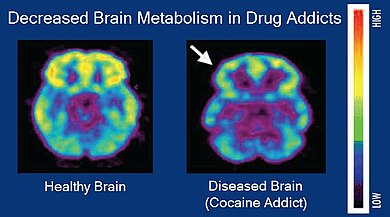Reward sensitization
| Addiction and dependence glossary |
-
addiction – a brain disorder characterized by engagement in rewarding stimuli despite adverse consequences
-
addictive behavior – a behavior that is both rewarding and reinforcing
-
addictive drug – a drug that is both rewarding and reinforcing
-
dependence – an adaptive state associated with a withdrawal syndrome upon cessation of repeated exposure to a stimulus (e.g., drug intake)
-
drug sensitization or reverse tolerance – the escalating effect of a drug resulting from repeated administration at a given dose
-
drug withdrawal – symptoms that occur upon cessation of repeated drug use
-
physical dependence – dependence that involves persistent physical– withdrawal symptoms (e.g., fatigue and delirium tremens)
-
psychological dependence – dependence that involves emotional–motivational withdrawal symptoms (e.g., dysphoria and anhedonia)
-
reinforcing stimuli – stimuli that increase the probability of repeating behaviors paired with them
-
rewarding stimuli – stimuli that the brain interprets as intrinsically positive and desirable or as something to approach
-
sensitization – an amplified response to a stimulus resulting from repeated exposure to it
-
substance use disorder – a condition in which the use of substances leads to clinically and functionally significant impairment or distress
-
tolerance – the diminishing effect of a drug resulting from repeated administration at a given dose
|
|
|
| Transcription factor glossary |
-
gene expression – the process by which information from a gene is used in the synthesis of a functional gene product such as a protein
-
transcription – the process of making messenger RNA (mRNA) from a DNA template by RNA polymerase
-
transcription factor – a protein that binds to DNA and regulates gene expression by promoting or suppressing transcription
-
transcriptional regulation – controlling the rate of gene transcription for example by helping or hindering RNA polymerase binding to DNA
-
upregulation, activation, or promotion – increase the rate of gene transcription
-
downregulation, repression, or suppression – decrease the rate of gene transcription
-
coactivator – a protein that works with transcription factors to increase the rate of gene transcription
-
corepressor – a protein that works with transcription factors to decrease the rate of gene transcription
-
response element – a specific sequence of DNA that a transcription factor binds to
|
|
|
Addiction is a brain disorder characterized by engagement in rewarding stimuli despite adverse consequences. Despite the involvement of a number of psychosocial factors, a biological process – one which is induced by repeated exposure to an addictive stimulus – is the core pathology that drives the development and maintenance of an addiction. The two properties that characterize all addictive stimuli are that they are reinforcing (i.e., they increase the likelihood that a person will seek repeated exposure to them) and intrinsically rewarding (i.e., they are perceived as being inherently positive, desirable, and pleasurable).
Addiction is a disorder of the brain's reward system which arises through transcriptional and epigenetic mechanisms and occurs over time from chronically high levels of exposure to an addictive stimulus (e.g., eating food, the use of cocaine, engagement in sexual intercourse, participation in high-thrill cultural activities such as gambling, etc.).ΔFosB, a gene transcription factor, is a critical component and common factor in the development of virtually all forms of behavioral and drug addictions. Two decades of research into ΔFosB's role in addiction have demonstrated that addiction arises, and the associated compulsive behavior intensifies or attenuates, along with the overexpression of ΔFosB in the D1-type medium spiny neurons of the nucleus accumbens. Due to the causal relationship between ΔFosB expression and addictions, it is used preclinically as an addiction biomarker. ΔFosB expression in these neurons directly and positively regulates drug self-administration and reward sensitization through positive reinforcement, while decreasing sensitivity to .
...
Wikipedia

